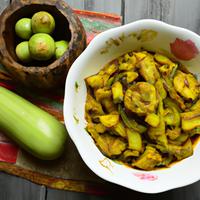
1 serving (150 grams) contains 80 calories, 2.0 grams of protein, 3.0 grams of fat, and 10.0 grams of carbohydrates.

Log this food in SnapCalorie

Nutrition Information
Calories |
126.2 | ||
|---|---|---|---|
% Daily Value* |
|||
| Total Fat | 4.7 g | 6% | |
| Saturated Fat | 0.8 g | 4% | |
| Polyunsaturated Fat | 0 g | ||
| Cholesterol | 0 mg | 0% | |
| Sodium | 473.2 mg | 20% | |
| Total Carbohydrates | 15.8 g | 5% | |
| Dietary Fiber | 4.7 g | 16% | |
| Sugars | 6.3 g | ||
| protein | 3.2 g | 6% | |
| Vitamin D | 0 mcg | 0% | |
| Calcium | 63.1 mg | 4% | |
| Iron | 1.6 mg | 8% | |
| Potassium | 315.5 mg | 6% | |
* Percent Daily Values are based on a 2,000 calorie diet. Your daily values may be higher or lower depending on your calorie needs.
Food Attributes
Source of Calories
About Bottlegourd sabji
Bottlegourd Sabji, a staple in Indian cuisine, is a simple yet nutritious dish made from bottle gourd (lauki), a low-calorie vegetable rich in dietary fiber, vitamins, and minerals. Typically, the sabji is seasoned with mustard seeds, cumin, turmeric, and green chilies, and cooked with onions, tomatoes, and garlic to create a flavorful and aromatic base. This dish is often served with chapati or rice, making it a wholesome meal choice. Known for its hydrating properties due to its high water content, bottle gourd aids digestion, promotes heart health, and supports weight management. The sabji is generally light, with minimal oil used, making it a healthy option. However, the nutritional value can vary if excess oil or cream is added during preparation, which might increase calorie content. Bottlegourd Sabji is a delightful way to enjoy traditional Indian flavors while reaping various health benefits.



